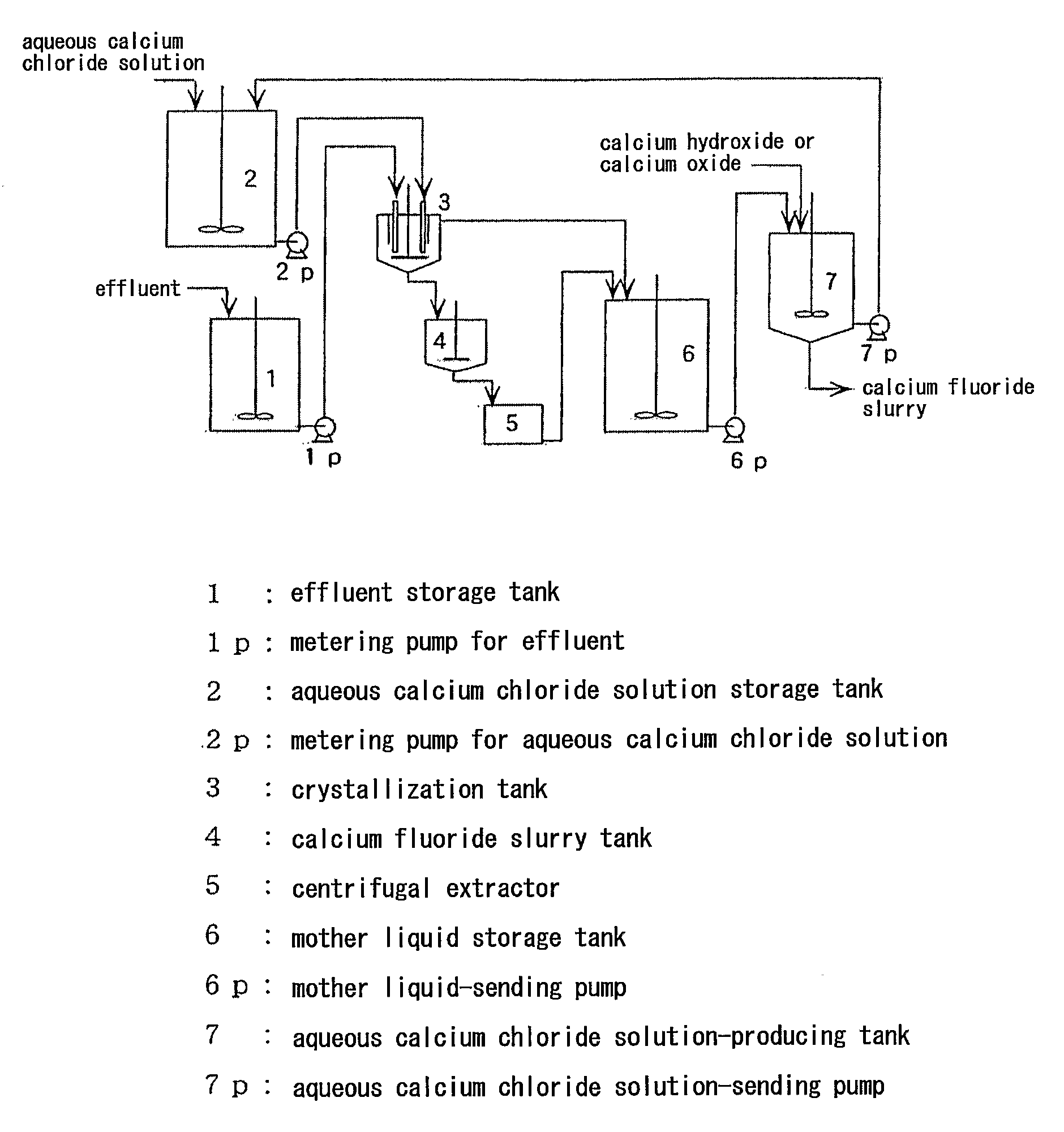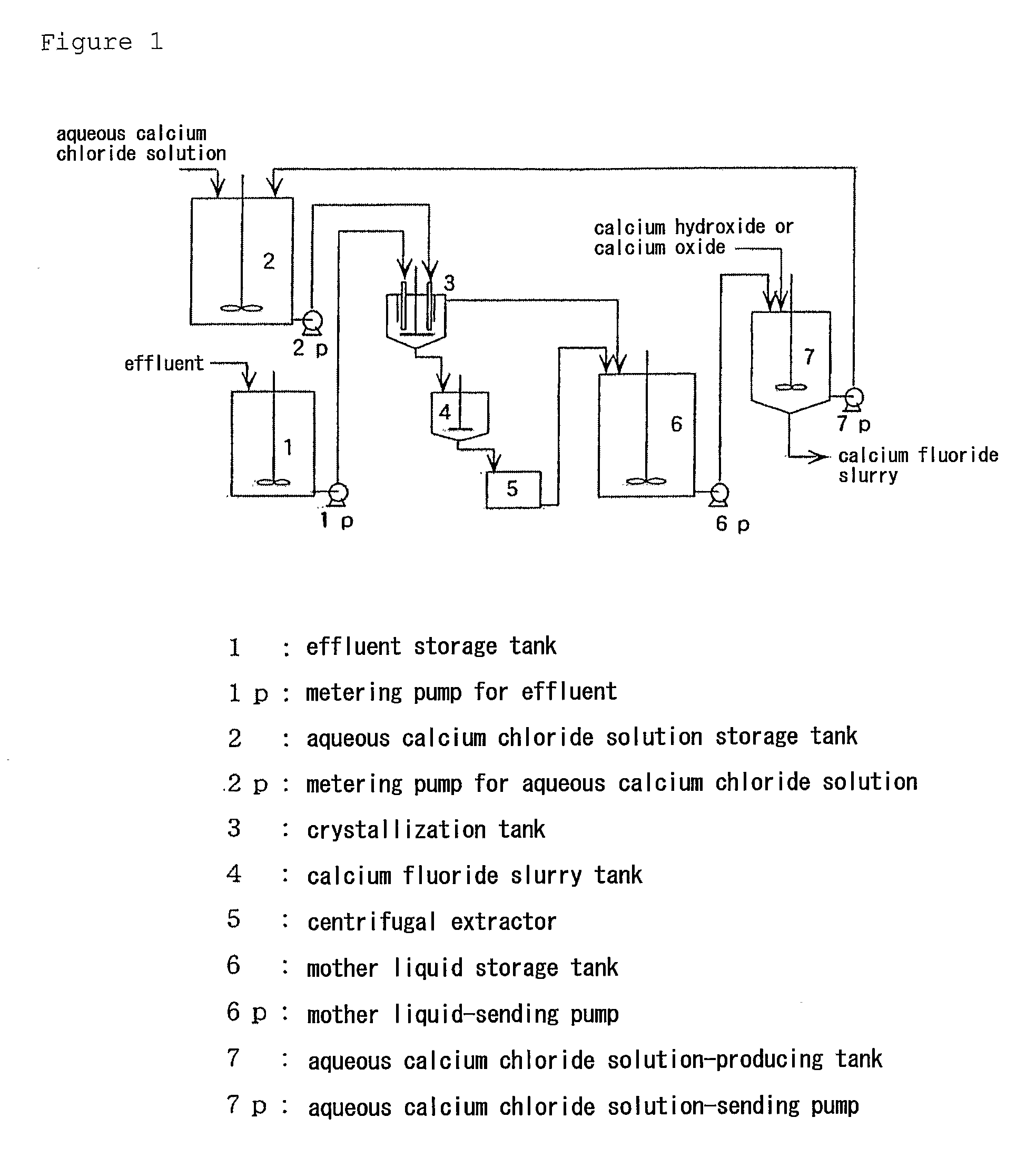Method For Producing Calcium Fluoride, Reusing Method And Recycling Method Thereof
a technology of calcium fluoride and recycling method, which is applied in the field of method for producing calcium fluoride, reusing method and recycling method thereof, can solve the problems of reducing the yield of hydrogen fluoride, looming disposal problems, and inability to reuse for industrial applications, and achieves high purity and suitable particle sizes
- Summary
- Abstract
- Description
- Claims
- Application Information
AI Technical Summary
Benefits of technology
Problems solved by technology
Method used
Image
Examples
example 1
[0066]A 5 L reactor made of Teflon (a registered trademark, hereafter) PFA provided with a Teflon stirrer accommodating 1,000 g of 5% hydrochloric acid, was set in a water bath of which the temperature is set to 50° C., and into the solution being stirred, 1,200 g of the blended solution consisting of 1,000 g of a neutral fluoride-containing effluent which contains 21.1% potassium fluoride, 7.2% potassium chloride and 0.4% sodium fluoride (7.1% fluoride in total), and of 200 g of 35% hydrochloric acid, and 1,482 g of a 14% aqueous calcium chloride solution were dropped at the same time in a preferable balance with a metering pump for five hours. In 10 minutes after the completion of dropping, stirring was stopped and the solution was suction-filtrated to recover 3,520 g of the filtrate. The residue was lightly washed and then dried at 120° C. for two hours, and 134.2 g of calcium fluoride was recovered (a recovery rate of 92%). The calcium fluoride had the purity of 99.1%, an averag...
example 2
[0067]A 5 L reactor made of Teflon PFA provided with a Teflon stirrer accommodating 1,000 g of 2% hydrochloric acid, was set in a water bath of which the temperature was set to 50° C., and into the solution being stirred, 1,100 g of the blended solution consisting of 1,000 g of an alkaline fluoride-containing effluent containing 2.4% sodium fluoride with a pH of 9 and 100 g of 35% hydrochloric acid, and 1,610 g of a 2% aqueous calcium chloride solution were dropped at the same time in a preferable balance with a metering pump for five hours. In 10 minutes after the completion of dropping, stirring was stopped and the solution was suction-filtrated to recover 3,650 g of the filtrate. The residue was lightly washed and then dried at 120° C. for two hours, and 15.0 g of calcium fluoride was recovered (a recovery rate of 67%). The calcium fluoride had the purity of 99.0%, the average particle size of 9.8 μm, and 0.23% of loss on ignition at 500° C. for two hours. The mother liquid conta...
example 3
[0068]A 5 L reactor made of Teflon PFA provided with a Teflon stirrer accommodating 1,000 g of 15% hydrochloric acid, was set in a water bath of which the temperature was set to 50° C., and into the solution being stirred, 1,000 g of a hydrofluoric acid-containing effluent containing 17.2% hydrofluoric acid and 15.0% hydrochloric acid, and 1,704 g of a 28% aqueous calcium chloride solution were dropped at the same time in a preferable balance with a metering pump for five hours. In 10 minutes after the completion of dropping, stirring was stopped and the solution was suction-filtrated to recover 3,400 g of the filtrate. The residue was lightly washed and then dried at 120° C. for two hours, and 287.6 g of calcium fluoride was recovered (a recovery rate of 86%). The calcium fluoride had the purity of 99.3%, the average particle size of 27.3 μm, and 0.23% of loss on ignition at 500° C. for two hours. The mother liquid contained 17.9% hydrochloric acid and 1.4% calcium fluoride. The pH...
PUM
| Property | Measurement | Unit |
|---|---|---|
| pH | aaaaa | aaaaa |
| temperature | aaaaa | aaaaa |
| particle size | aaaaa | aaaaa |
Abstract
Description
Claims
Application Information
 Login to View More
Login to View More - R&D
- Intellectual Property
- Life Sciences
- Materials
- Tech Scout
- Unparalleled Data Quality
- Higher Quality Content
- 60% Fewer Hallucinations
Browse by: Latest US Patents, China's latest patents, Technical Efficacy Thesaurus, Application Domain, Technology Topic, Popular Technical Reports.
© 2025 PatSnap. All rights reserved.Legal|Privacy policy|Modern Slavery Act Transparency Statement|Sitemap|About US| Contact US: help@patsnap.com



